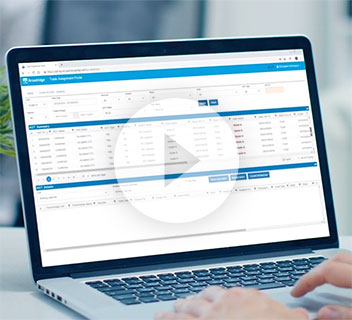
Video
Introducing the Trade Assignment Portal
read moreAdditional Broadridge resources:
View our Contact Us page for additional information.
Our representatives and specialists are ready with the solutions you need to advance your business.
Want to speak with a sales representative?
| Table Heading | |
|---|---|
| +1 800 353 0103 | North America |
| +442075513000 | EMEA |
| +65 6438 1144 | APAC |
Your sales rep submission has been received. One of our sales representatives will contact you soon.
Want to speak with a sales representative?
| Table Heading | |
|---|---|
| +1 800 353 0103 | North America |
| +442075513000 | EMEA |
| +65 6438 1144 | APAC |

Second only to U.S. Treasuries in trading volume, the to-be-announced (TBA) market is the most liquid and, consequently, the most important secondary market for mortgage loans, according to the Securities Industry and Financial Markets Association (SIFMA).1 In addition, more mortgage debt has been available to trade, causing volume to tick upward.2 Yet, all participants involved in the process of assigning TBA trades – mortgage originators, asset managers and broker-dealers – continue to deal with fragmented processes that cause errors, add cost and strain operations staff.
The TBA market facilitates the forward trading of mortgage-backed securities (MBS) issued by Government-Sponsored Enterprises (GSEs) such as Fannie Mae and Freddie Mac, as well as Ginnie Mae. Because trade settlements are scheduled significantly into the future, the market is critical for allowing mortgage lenders to hedge and/or fund their origination pipelines against the risk of changing interest rates and lock in a price for the mortgages they are in the process of originating.
However, the process continues to be manual, labor-intensive and prone to error since much of it is handled through email and PDF contracts, or through online tools that fail to reach all participants in the process. Several different workflows and communication formats exist across buy-side firms and originators. Large broker-dealers may process between 3,000 and 5,000 trade assignments per month, requiring two or three full-time employees to process them – at the expense of underutilized risk and exception management.
A Costly, Manual Process Prone to Error
The Assignment of Trades (AOT) in the TBA market is typically a manually-intensive paper process which requires handwriting, scanning and creating PDFs then communicating via email or even fax. Too many variables that fragment the process, such as hunting for information in different systems or files and placing it in PDFs, increases the risk of errors which leads to degraded quality of information contained in documents. The lack of a standardized process makes information difficult to track, log and archive executed AOTs, which increases operational risk. And with peak AOT processing coinciding with monthly allocation cycles, teams are stretched even further.
Although risk and exception management remain paramount functions in broker-dealers’ operations, staff end up spending a bulk of their time on this cumbersome, manual process of trade assignments. At the same time, buy-side firms face similar process issues regardless of available commercial platforms to help. In the current environment, buy-side firms must settle with each broker-dealer and set up costly wire agreements with individual banks and asset managers.
A More Effective Approach to AOTs
While platforms do exist in the market to handle the AOTs in the TBA market, a significant amount of the work is performed outside of these platforms, particularly among mortgage originators and some of the larger buy-side firms. Some buy-side firms have expressed dissatisfaction with current methods of generating average trade price, which can result in multiple wire payments. A vast majority of originators, meanwhile, tend to handle most of their assignments manually.
In order for technology to provide a truly streamlined, error-free process while reducing needless risk and cost, the whole street must be connected through one platform that allows mortgage originators, buy-side and sell-side firms to communicate and process information related to the AOT. Firms who spend an inordinate amount of time and resources on tasks could greatly benefit from a platform that offers more seamless communication and processing across all participants. This would also allow broker-dealers to focus on risk and exception management, rather than on mundane operational activities, and eliminate any improper adoption of SIFMA forms which can make the process even more challenging for broker-dealers.
A Centralized Platform for the Whole Street
A single electronic platform for trade assignments would enable all participants to electronically initiate, review, accept and sign AOT requests. With a streamlined, straight-through process of AOT-related workflow, the full gamut of buy-side and sell-side AOTs can be processed in one place. This would include agency-generic TBAs, STIP TBAs, and specified pool trades, complete with automatic matching of incoming AOT requests to trade and efficient creation of assignment trades.
This secure, centralized and web-based utility would allow participants to electronically send and receive trade assignments using an automated workflow to process assignments and tailored exception-based workflows – regardless of the back-office platform they use. E-signatures eliminate the need to download, sign, scan and email PDFs, and a single wire to settle for mortgage originators and asset managers would reduce costs. In addition, complete transparency of trade assignment process eliminates the need for follow-up phone calls.
Addressing a Range of Operational Inefficiencies
Clearly, inefficiencies are prevalent in the TBA market. But as more mortgage originators, asset managers and broker-dealers join the utility, all participants would have the potential to gain a wider range of operational efficiencies. Viewing and reconciling open commitments, managing pair-off par and pair-off money between member firms are just a few of the capabilities that would give firms the ultimate value they’re seeking. With improved workflows, they could finally begin shifting their focus from operational activities to risk and exception management.
Participants would also not have to worry about keeping track of who is or isn’t on the network and the effects on workflows. A central utility would keep track of members and non-members, eliminating the need for mortgage originators and asset managers to do so. Furthermore, they could still preserve the choice of interacting with a non-member via email while maintaining a seamless process for the user.
More Complexity Ahead
The time is now for the whole street of participants to gain fully transparent and efficient communication and processing of AOT related information among participants. With Freddie Mac and Fannie Mae getting ready to issue a common mortgage-backed security via the Single Security Initiative, a wide range of systems and processes will be impacted1, potentially adding more cost and complexity amid rising market volumes. Only a centralized platform accessible and utilized by mortgage originators, asset managers and broker-dealers can truly modernize and transform the way they interact across the market, and ultimately change the game for all participants.